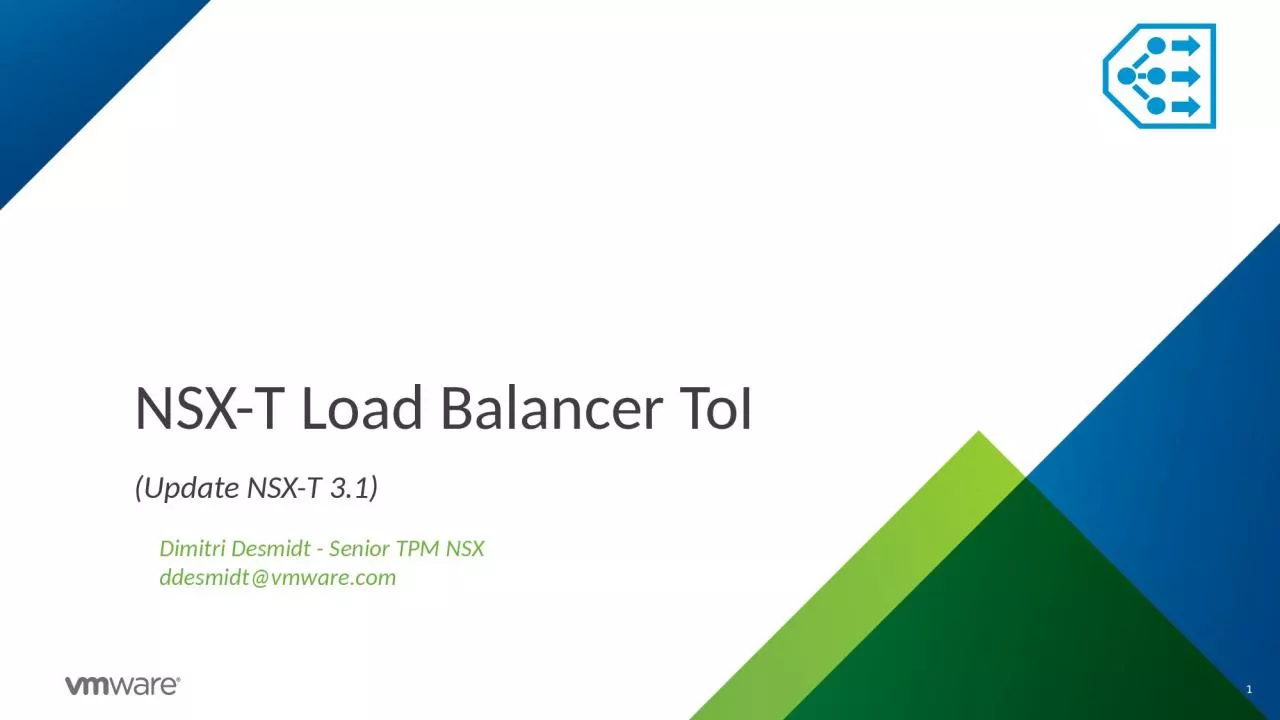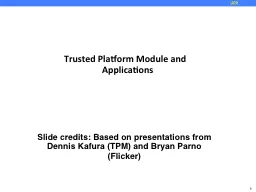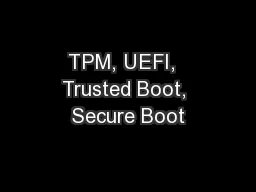PPT-Dimitri Desmidt - Senior TPM NSX
Author : Gunsmoke | Published Date : 2022-08-04
ddesmidtvmwarecom NSXT Load Balancer ToI Update NSXT 31 1 NSXT 31 LB enhancements 2 NSXT LB Technical Overview 3 NSXT LB Technical Deep Dive 4 Demo 5 Key Takeaways
Presentation Embed Code
Download Presentation
Download Presentation The PPT/PDF document "Dimitri Desmidt - Senior TPM NSX" is the property of its rightful owner. Permission is granted to download and print the materials on this website for personal, non-commercial use only, and to display it on your personal computer provided you do not modify the materials and that you retain all copyright notices contained in the materials. By downloading content from our website, you accept the terms of this agreement.
Dimitri Desmidt - Senior TPM NSX: Transcript
ddesmidtvmwarecom NSXT Load Balancer ToI Update NSXT 31 1 NSXT 31 LB enhancements 2 NSXT LB Technical Overview 3 NSXT LB Technical Deep Dive 4 Demo 5 Key Takeaways 6 QampA. Bulletproof . Windows BitLocker. Sami Laiho - . Sovelto. W. IN-B314. http://www.samilaiho.com/. MVP Windows Expert – IT Pro. SpringBoard. Technical Expert Panel member. Senior Technical Fellow @ . Rafael Mantilla Montalvo. Cisco Systems. June 2013. From Counterfeit to Trusted Systems. . . . . Counterfeit. Secure Boot. Device Identity. Authentication. Counterfeiter. Signing Key. SIMPLE RULES FOR ECONOMIC PLANTWIDE CONTROL. Vladimiros . Minasidis. a. , . Sigurd. . Skogestad. a. , . Nitin . Kaistha. b. a. Dept. . of Chemical Engineering, Norwegian University of Science and Technology, . ECONOMIC PLANTWIDE CONTROL. Sigurd Skogestad. Dept. . of Chemical Engineering, Norwegian University of Science and Technology, . . Trondheim, Norway. Trondheim, Norway . Trondheim. Oslo. UK. NORWAY. Jonathan M. McCune, . Yanlin. Li, . Ning. . Qu. , . Zongwei. Zhou, . Anupam. . Datta. , Virgil . Gligor. , Adrian Perrig. May 17, 2010. 2. Motivating Example. Conscientious web server admin / dev. Slide credits. : Based on presentations from Dennis . Kafura. . (TPM) and Bryan . Parno. (Flicker). Trusted Platform Module. Integrity Measurement, Reporting, and Evaluation. Motivation. Reliance on remote clients/servers. ECONOMIC PLANTWIDE CONTROL. Sigurd Skogestad. Dept. . of Chemical Engineering, Norwegian University of Science and Technology, . . Trondheim, Norway. Trondheim, Norway . Trondheim. Oslo. UK. NORWAY. Xiaolong. . Wang, . Xinming. . Ou. Based on Dr. Andrew Martin’s slides from TIW 2013. Problem. We use different devices (smartphone, laptop, tablet, Xbox, router…) and grant them with authority everyday (Gmail/Facebook account, credit card, personal info, etc.). SIMPLE RULES FOR ECONOMIC PLANTWIDE CONTROL. Vladimiros . Minasidis. a. , . Sigurd. . Skogestad. a. , . Nitin . Kaistha. b. a. Dept. . of Chemical Engineering, Norwegian University of Science and Technology, . How Does a PC Boot?. First: History. http://en.wikipedia.org/wiki/Booting. Code entered on Hand Switches. Non-Volatile Memory; infrequent cold boot. Development of ROM-based IPL. PC developed multi-stage boot process. VITOVITO oiltester was developed for the measurement of all sorts of frying mediumFunctionalityThe VITO oiltester easily quickly and reliably determines the quality of your oil To do so it measures th kindly visit us at www.nexancourse.com. Prepare your certification exams with real time Certification Questions & Answers verified by experienced professionals! We make your certification journey easier as we provide you learning materials to help you to pass your exams from the first try. kindly visit us at www.nexancourse.com. Prepare your certification exams with real time Certification Questions & Answers verified by experienced professionals! We make your certification journey easier as we provide you learning materials to help you to pass your exams from the first try. kindly visit us at www.examsdump.com. Prepare your certification exams with real time Certification Questions & Answers verified by experienced professionals! We make your certification journey easier as we provide you learning materials to help you to pass your exams from the first try. Professionally researched by Certified Trainers,our preparation materials contribute to industryshighest-99.6% pass rate among our customers.
Download Document
Here is the link to download the presentation.
"Dimitri Desmidt - Senior TPM NSX"The content belongs to its owner. You may download and print it for personal use, without modification, and keep all copyright notices. By downloading, you agree to these terms.
Related Documents














